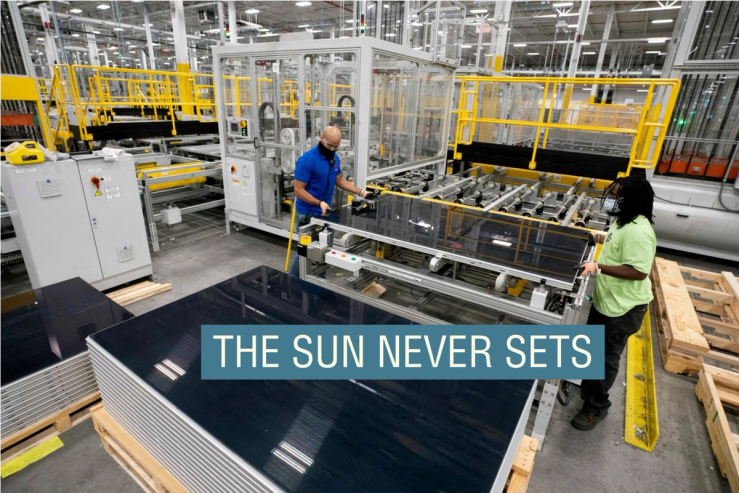The Facts
A former top economic advisor to Presidents Barack Obama and Joe Biden, who is now advising Vice President Kamala Harris’s campaign, said in an interview with Semafor that the US should counter China’s overwhelming dominance of global clean energy supply chains by underwriting middle-income countries’ purchases of US-made hardware.
The US needs a “clean energy Marshall Plan” to make the clean energy trade war with China less destructive, and take the environmental and economic benefits of the Inflation Reduction Act global, Brian Deese wrote in the latest edition of Foreign Affairs. Deese declined to say whether Harris has endorsed this plan yet. But his plan offers a blueprint for how Harris, if elected, might seek to shift the US strategy away from relying on tariffs (although some will still be needed), and toward US taxpayer-backed loans and loan guarantees for clean energy buyers in developing countries. The policy aims to make US exports more affordable relative to cheaper Chinese alternatives, and to help establish a broader base of suppliers of raw materials and components so the world is less singularly reliant on China.
Although the climate benefits of Deese’s plan might be less attractive to a second Donald Trump administration, its ultimate outcome — creating bigger markets for US businesses — is designed to have bipartisan appeal.
Tim’s view
Part of the original rationale for the IRA was that scaling up US manufacturing of solar panels, batteries, and other hardware will speed up global decarbonization by bringing down prices. The problem with this theory has always been that China’s production costs are already so low that US exporters can’t compete, and that encouraging other countries to shop in the US instead of China would only make the energy transition slower and more expensive. The IRA’s global dividend, Deese said, “is not self-executing. It’s going to require additional policy tools to capture it.”
The idea that every developing country should just import clean tech cheaply from China forever isn’t economically or politically viable among US policymakers. But Deese’s plan isn’t about simply replacing China with the US in the global clean energy market. It’s about diversifying the whole ecosystem by making it more affordable for a broader range of countries to participate. That makes the energy transition more resilient to supply disruptions, and is effectively a way to make bigger US contributions to global climate finance — which remain pitifully behind their fair share, based on the country’s carbon footprint — more palatable to Congress by clearly linking them to the bottom lines of US companies, especially in the Republican-majority districts that have captured most IRA-related investment so far. Deese’s plan especially calls for supporting the global adoption of cutting-edge climate technologies where the US already has an edge over China, including geothermal and advanced nuclear power.
How much will all this cost? Deese isn’t ready to put a specific number on it, other than “significant.” But unlike the original Marshall Plan, which was composed almost entirely of grants, he envisions his plan as being built mostly of loans, which should improve its chances in Congress.
“I’m optimistic,” he said. “There is already a bipartisan understanding that we need to have a more viable alternative to China’s Belt and Road. This plan gives [politicians] a credible way to go to communities across the country and say: ‘This is in your core economic interest, today’.”
The View From Brian Deese
This conversation has been edited for length and clarity.
Tim McDonnell: Why is it so important to build bigger markets for US clean tech exports?
Brian Deese: If we’re thinking about where the most significant future emissions are coming from, and where the most significant investment and transformation needs to take place in the next couple of decades, it’s outside the United States. So driving the US economic capacity in clean energy, and then scaling that globally is the most credible way we can really accelerate decarbonization globally.
Also, this is what’s most relevant about the analogy of the Marshall Plan. People think about the Marshall Plan in terms of our generosity to Europe in the postwar period. But equally if not more important was an industrial strategy to extend markets for US producers who had built capacity during the war. So a strategy that is as generous to our allies as it is pro-American is both economically and politically the right approach. If we position US innovators to gain a growing share of growing global markets, while also being a generous and reliable partner to a number of strategically important developing countries that are struggling, then we have an opportunity to advance our strategic and economic interests in a significant way.
TM: So how would this work, and how much money are we talking about here?
BD: The first piece is for the US to have a financing authority at the scale and with the flexibility to meet the challenge. And it needs to be able to work with countries that are looking at their own energy transitions and identify where we can use US public capital in a nimble way — loans, loan guarantees, debt, equity — to catalyze project investments. The second piece is what I call a resilience authority, which would give the US a set of new tools to intervene in global markets and make them more stable, like we do with the Strategic Petroleum Reserve, to unlock greater investment. For example, entities that are looking to invest in lithium today are really struggling with the volatility of the lithium price. The third piece is having a realistic, harmonized strategy of tariffs and border adjustments that addresses head-on China’s role in these markets, and encourages greater trade rather than more isolation.
TM: How does what you’re proposing here differ from the approach China has taken up to now in coming to dominate the global clean energy trade?
BD: I don’t think it’s either feasible or advisable to have a view that this is a zero-sum competition between the US and China, or China and the rest of the world. China will continue to play an incredibly important role in global clean energy supply chains. But the strategy that China is employing today, which is explicitly about over-production for export and under-consumption domestically, is not sustainable for the Chinese economy or the global economy. We need to move to an equilibrium that has more balance and more resilience. Building up more diversification in supply chains not only by expanding US export capacity, but also building capacity in other countries. And being prepared to internationalize our approach to tariffs, so that when we are speaking to some of the serious concerns, for example, around Chinese over-capacity in an area like steel, we’re reflecting that it’s not just the US that’s concerned, it’s also Brazil and Vietnam and Canada and Mexico, all bringing trade actions together.
TM: Right, because if your goal was strictly to reach net zero as fast as possible, wouldn’t it be better to just let China make all this stuff as cheaply as possible? Is there a risk that clean tech adoption actually slows down if we’re trying to get countries to buy products from the US that are more expensive?
BD: It’s a super fair question. One, a strategy where China deliberately uses non-market mechanisms to become the dominant producer is not a sustainable strategy to address climate change in the medium term. The idea that China produces everything and everybody else just relies on them is not a viable economic or political strategy. The question is, how do we get to an equilibrium that acknowledges that China will continue to play an important role, but works toward more diversification rather than more domination? The goal here is not to just replace Chinese production with US production, but to build a more stable and diversified base of technologies globally.
TM: Is there a risk that China would respond to a plan like what you’re proposing with more of its own trade restrictions, like we’ve seen over the last year with graphite exports?
BD: It’s a complicated issue that you want to manage carefully. I don’t believe the right strategy is an aggressive, unilateral escalation with China. The proposals on the far end to sort of try to decouple entirely from China are unrealistic. There is a prudent way of engaging China and others to avoid miscalculation. Frankly, one of the reactions I would anticipate is actually in the other direction, that China says, ‘We’re going to double down on the Belt and Road Initiative, make it more generous, less extortionary, and more genuinely green.’ Then you would have helped to move China in a more constructive direction when it thinks about its role outside of China.
Room for Disagreement
China is already taking steps on its own to improve the green credentials of the BRI, including with a commitment to not finance any new overseas coal-fired power plants. And the country is ramping up programs designed to accelerate adoption of clean tech domestically.


